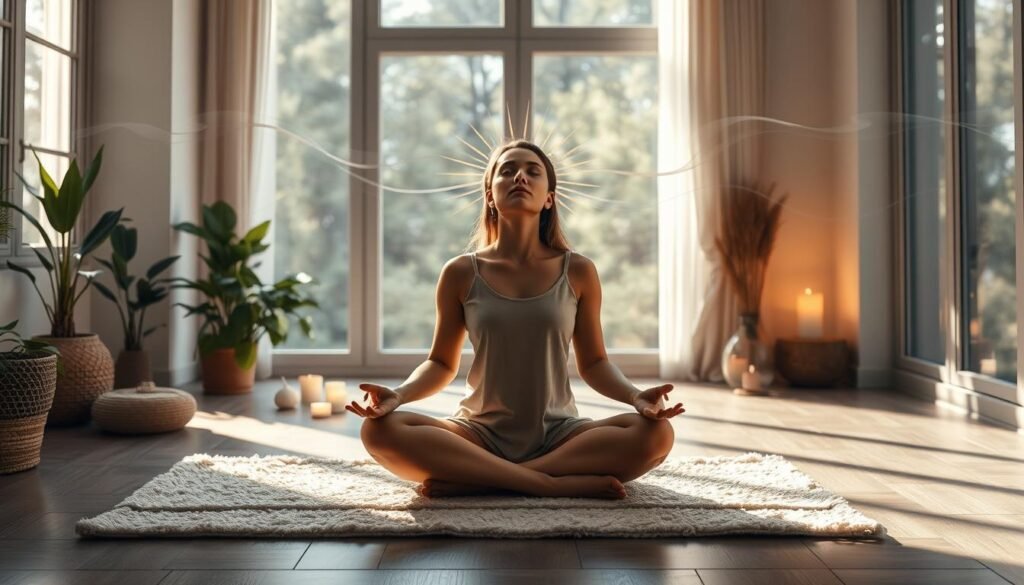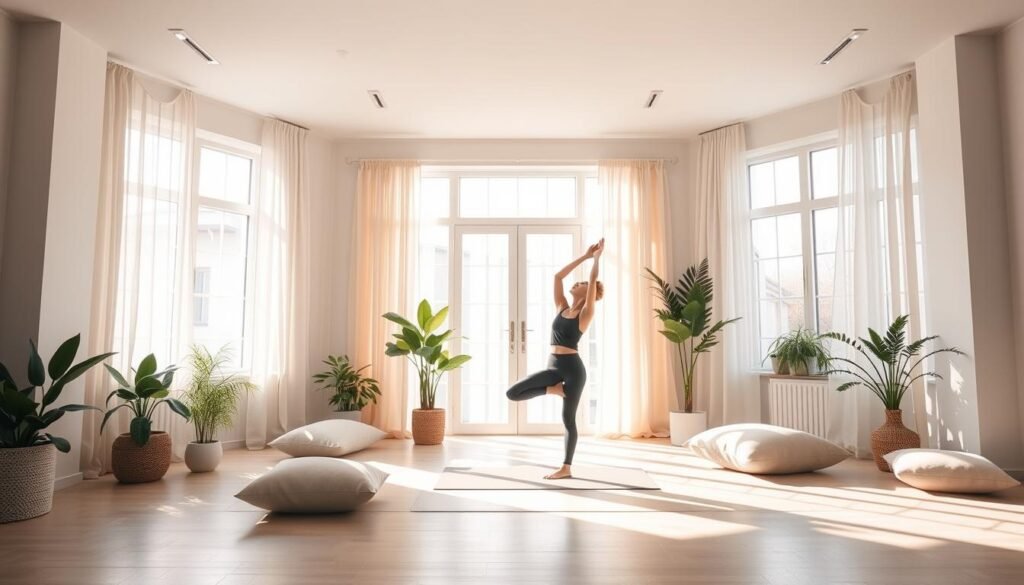Did you know that nearly 19% of American adults had an anxiety disorder last year? This information comes from the National Institutes of Health. It shows how common anxiety is and the need for helpful solutions. Effective breathing techniques stand out as a powerful tool for anxiety relief. Breathing exercises have been proven to calm people down instantly. They improve mood when stress levels are high. Techniques like diaphragmatic and mindfulness breathing not only relax but also have long-term benefits.
Adding these breathing exercises to daily life can lessen stress and boost emotional health. Learning to control breathing leads to more calmness and focus. This makes everyday challenges easier to handle. At work or home, taking time for breathing exercises can greatly improve mental health.
Key Takeaways
- Breathing exercises can immediately calm anxiety and elevate mood during stress.
- Diaphragmatic breathing alters how the autonomic nervous system functions for better stress management.
- Regular practice of breathing techniques can lead to long-term reductions in anxiety symptoms.
- Techniques like box breathing, used by Navy SEALs, can enhance calmness in high-stress situations.
- Mindfulness meditation combined with breath awareness is effective in reducing anxiety.
- Breathing exercises can be easily integrated into daily routines and workplace activities.
Understanding Anxiety and Its Symptoms
Anxiety is a common emotional issue in the United States. It ranges from slight discomfort to deep panic. While many people feel anxious at times, some develop more serious anxiety disorders. These lead to excessive fear over everyday events.
Common anxiety disorders include generalized anxiety, social anxiety, and panic attacks. Each one has its own emotional and physical effects. Symptoms like quick breathing, a fast heartbeat, restlessness, and trouble concentrating are common. Many also have sleep problems, affecting their life and health.
Spotting these anxiety symptoms early is key to get help. One helpful strategy is breathing exercises. Techniques like taking deep breaths from the diaphragm offer quick calming. They boost oxygen, lower blood pressure, and slow the heartbeat, easing stress indicators.
Studies show these exercises help beyond standard treatments for those with anxiety. While severe cases might need professional care, deep breathing can provide control over anxiety. Dr. Megan Riehl’s method is great for learning more about deep breathing for anxiety relief. Visit this resource to discover more.
The Importance of Breathing Techniques for Anxiety Management
Breathing techniques are key in fighting anxiety. They trigger our body’s relaxation mode, helping to stop panic in its tracks. By focusing on calm breathing, we lessen anxiety’s power. Studies show that deep breaths affect our nervous system. It changes our fight-or-flight response and helps us relax with long breaths out.
Practicing breathing methods that focus on longer exhales is beneficial. For instance, breathe in for four seconds and out for six. This simple rhythm can ease stress. Making this a daily habit for just ten minutes can bring peace. Also, belly breathing a few times daily adds to this effect, promoting relaxation.
Exploring breathing for relaxation is another great step. Techniques like breath focus require setting aside time each day. This practice connects people with their body’s natural rhythms. Resonant breathing, with its six-second breaths in and out, is particularly good for anxiety.
There are many breathing practices to try, like the lion’s breath and alternate nostril breathing. Mindful breathing helps too, fostering focus on the present. Adding these methods into everyday life can cut down on anxiety. It leads to a calmer and more relaxed state.
Types of Breathing Exercises for Anxiety
There are many breathing exercises to help with anxiety. They can bring relaxation and better emotional control. They are a good way to feel better mentally.
Diaphragmatic Breathing
Diaphragmatic breathing is also known as belly breathing. It involves deep breaths that use the diaphragm. This helps increase airflow and oxygenation, making you feel calm. Research supports its benefits for those with anxiety disorders. It lessens anxiety symptoms and increases relaxation.
Controlled Breathing Exercises
Controlled breathing exercises set a breathing rhythm that helps reduce anxiety. The 4-7-8 method is one example, where you inhale, hold, and exhale in a specific pattern. This not only soothes the mind but also helps control stress responses. Studies have shown that these exercises can cut down cortisol levels and ease stress.
Mindfulness Breathing Exercises
Mindfulness breathing exercises help you stay aware of your breath. This fosters a strong connection between your body and mind. Focusing on the here and now can lessen anxiety and increase relaxation. Practices like alternate nostril breathing help free your mind from fast thoughts. They promote emotional balance and peace.
| Breathing Exercise Type | Benefits |
|---|---|
| Diaphragmatic Breathing | Improves oxygen delivery, enhances relaxation, reduces anxiety symptoms |
| Controlled Breathing Exercises | Establishes rhythm, lowers cortisol levels, promotes calmness |
| Mindfulness Breathing Exercises | Enhances present-moment awareness, fosters emotional regulation, decreases anxiety |
Deep Breathing Techniques to Reduce Stress
Deep breathing is key to reducing stress. It improves oxygen flow and calms you down. By taking slower breaths, your heart rate drops, bringing tranquility. Practicing these breathing techniques not only helps with anxiety but also boosts your physical health. It strengthens overall well-being and emotional stability.
How Deep Breathing Works
Deep breathing works wonders for your body. It lowers the stress hormones, making you feel relaxed. Studies show that “belly breathing” for 20 to 30 minutes daily can cut stress and anxiety. This helps your body heal from tension and tiredness.
Common Deep Breathing Exercises
- Pursed Lip Breathing: This is great for people with lung problems like emphysema. Doing it four to five times daily can improve lung health.
- 4-7-8 Breathing: This method is a natural calm-down for your nerves.
- Box Breathing: You breathe in, hold, breathe out, and hold again for the same time. It helps maintain emotional steadiness.
- Resonance Breathing: You breathe gently in and out for six seconds each. It lessens anxiety and can be done for up to 10 minutes.
These breathing exercises significantly lower stress by soothing the nervous system. They encourage relaxation. For more tips on relaxing breath techniques, visit this resource.

Breath Focus Techniques for Enhanced Calm
Breath focus techniques are key to feeling calmer. They help you pay attention to breathing. This keeps you in the now, cutting down on stress and improving your mood.
Focusing on Your Breath
Finding a cozy spot is the first step. Make sure you’re away from distractions like TVs. Start with deep breaths: inhale for 4 seconds, hold for 2 seconds, and exhale for 6 seconds. It’s great for getting more oxygen and relaxing. If you’re new, try inhaling for 3 seconds, holding for 1 second, and exhaling for 4 seconds.
Chanting or Using Keywords
Chanting words like “safe” or “relax” can make you more relaxed. Doing this while concentrating on your breath helps lower stress. Try these methods daily to better manage anxiety and stress.
Resonant Breathing for Tranquility
Resonant breathing is also known as coherent breathing. It’s a method that uses slow, rhythmic breath patterns. You breathe in for a count of six and then out for the same time. This helps bring a deep sense of calm.
By doing resonant breathing, you can feel more peaceful because it lowers your blood pressure and brightens your mood. This practice makes you calm and helps with stress and anxiety during tough times.
What is Resonant Breathing?
Resonant breathing is about syncing your breathing to a steady rhythm. It aims for around five full breaths a minute. This helps with your heart rate variability (HRV) and lowers stress. Anyone looking for peace can easily use resonant breathing.
Benefits of Resonant Breathing
Resonant breathing helps in many ways beyond just relaxing you. Here are some benefits:
- Stress Reduction: This technique helps you feel less stressed and more at peace.
- Improved Mood: People often feel emotionally better after doing resonant breathing regularly.
- Better Heart Rate Variability: It improves HRV, which is good for your heart health.
- Support for Mental Health: Studies show resonant breathing can help reduce depression symptoms, especially with yoga.
Adding resonant breathing to your everyday life has great benefits. It not only relaxes you but also supports your mental and physical well-being.
| Benefits | Description |
|---|---|
| Stress Reduction | Helps in lowering stress levels through rhythmic breathing. |
| Improved Mood | Enhances emotional well-being and mood stability. |
| Heart Rate Variability | Optimizes HRV, thus benefiting cardiovascular health. |
| Mental Health Support | Assists in alleviating symptoms of anxiety and depression. |
Exploring Relaxation Breathing Methods
Relaxation breathing methods are key in managing anxiety and improving well-being. They help individuals face stress, leading to calmer minds and bodies. Among these techniques are long exhalation and the 4-7-8 breathing method.
Long Exhalation Techniques
Long exhalation focuses on a slower release of breath. It activates the calming part of the nervous system, reducing the stress response. This slows the heart rate and promotes relaxation, standing out as a strong relaxation method.
4-7-8 Breathing
The 4-7-8 technique is a go-to method for stress relief. It involves a deep inhale for four seconds, holding it for seven, then a slow eight-second exhale. This routine calms mind and body alike. By practicing regularly, it can better sleep and reduce anxiety.
Utilizing Yoga for Anxiety Relief
Adding yoga to daily life can help with anxiety. Many find yoga for anxiety helpful because it combines movement, mindfulness, and breath control. Through yoga, breathing helps calm both mind and body, letting people find calm during tough times.

Yoga teaches special breathing techniques, called pranayama, for anxiety relief. Techniques like deep breathing, alternate nostril breathing, and relaxation methods can calm the nervous system. They also clear the mind.
- Deep belly breathing can lower heart rate and bring calm.
- Alternate nostril breathing helps balance emotions and sharpen focus.
- Yoga Nidra provides a guided relaxation that reduces stress.
Studies show 54% of yoga participants saw anxiety improvement over three months. This makes yoga a strong support for cognitive therapy. By using these breathing techniques, people find real help in fighting anxiety relief. It leads to peacefulness.
Yoga combines exercise, breathing, and awareness for anxiety control. It helps individuals manage their mental health, building strength against stress.
Incorporating Breathing Exercises into Your Daily Routine
Daily breathing exercises can make you calmer and more focused. It takes commitment to manage anxiety this way. Yet, spending a few minutes each day on these exercises teaches your body to deal with stress better.
Starting with simple steps helps. The 4-4-8 technique, for example, is great for relaxation. You breathe in for four seconds, hold it for four, and exhale for eight. Doing this 3-4 times reduces stress. Belly breathing is another effective method. Breathe in for four seconds, hold for two, and breathe out over six seconds. It helps balance your body’s cortisol levels.
Mobile apps offer structured breathing exercises. Try breathing 6 to 10 times per minute for about two to three minutes. It helps you relax. Box Breathing is another technique. Used by Navy SEALs, you inhale, hold, and exhale. Each step lasts four seconds. It boosts your focus and calm.
If you do yoga, add counted breathing patterns to it. Let each exhale be longer than each inhale. This builds up your defense against anxiety. With nearly 40 million U.S. adults facing anxiety, these exercises can bring big improvements.
Everyday dedication to these exercises can lead to a calmer you. It makes dealing with stress much easier.
The Science Behind Breathing Techniques and Anxiety
Research shows the science of breathing techniques helps manage anxiety. They engage the vagus nerve, key for heart rate regulation and calmness. Learning these methods can enhance mental health significantly.
Impact on the Vagus Nerve
The vagus nerve is vital for stress response. Controlled breathing that activates this nerve can slow heart rate and lower blood pressure. Slow, rhythmic breathing boosts the nervous system, reducing anxiety and fostering peace.
Physiological Changes during Breathing Exercises
Breathing exercises cause important body responses, aiding in managing anxiety. For example, slow breathing can lower heart and respiratory rates, reducing stress. Techniques like nasal breathing improve oxygen flow and brain synchronization, enhancing well-being.

Guided Meditation to Complement Breathing Practices
Guided meditation is great alongside traditional breathing practices for controlling anxiety. It lets people connect deeply with their breath through calming prompts and visualization. This makes their enhancing breathing exercises much more effective. Together, they bring deep relaxation which is perfect for those fighting anxiety.
Adding guided meditation to your daily routine aids in developing mindfulness. It also provides a structured approach to meditation for anxiety. Studies, like one from 1992 in the American Journal of Psychiatry, show its effectiveness. It works well with breathing techniques, making you more mindful of thoughts and feelings.
Studies show that mindfulness exercises like guided meditation boost well-being. Just 10 minutes a day can sharpen focus and reduce anxiety. Making guided meditation a routine can improve emotional strength and stress handling over time.
For more info on how guided meditation can ease anxiety and enhance breathing techniques, explore various methods. Regular practice can help achieve a calm way of dealing with anxiety, leading to more peace of mind.
Conclusion
In summary, learning different ways to breathe can really help with anxiety. Using diaphragmatic breathing, exercises, and practices like mindfulness can make a big difference. Each method has its own way of helping, like calming us through special breathing patterns. Practices like box breathing and the 4-7-8 technique can give us moments of peace even when we’re stressed.
Also, mixing these breathing exercises with yoga and mindfulness meditation can really boost our mental health over time. Studies suggest that doing these regularly can help us deal with anxiety better and help us relax. Just spending 5-10 minutes a day on these techniques can make them fit easily into anyone’s schedule.
But, it’s important to remember that while breathing exercises are great for easing anxiety, they don’t replace advice from doctors, especially for those with health issues. Exploring these exercises can offer self-help relief, leading to a calmer and more satisfying life.